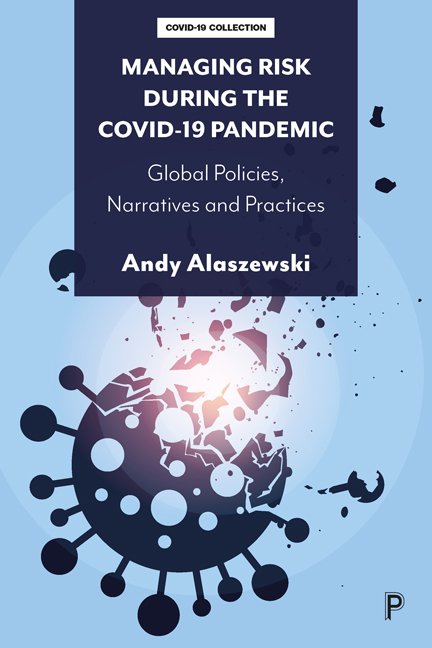Book contents
- Frontmatter
- Dedication
- Contents
- List of tables
- List of abbreviations
- About the author
- Acknowledgements
- Foreword
- Preface
- 1 Introduction: risk as a key feature of late modern societies
- PART I Responding to the challenges of the pandemic
- PART II Mitigating risk through science and technology
- PART III Risk narratives
- References
- Index
8 - Contesting risk: conspiracy theories
Published online by Cambridge University Press: 20 January 2024
- Frontmatter
- Dedication
- Contents
- List of tables
- List of abbreviations
- About the author
- Acknowledgements
- Foreword
- Preface
- 1 Introduction: risk as a key feature of late modern societies
- PART I Responding to the challenges of the pandemic
- PART II Mitigating risk through science and technology
- PART III Risk narratives
- References
- Index
Summary
Risk, broadcasting and social media
Trust, risk and communication
With the development of mass media, individuals can access a wide range of competing sources of information. Individuals have to decide which sources they trust and which they do not (Luhmann, 1993, pp 1– 31). For information derived from a source that an individual has personal knowledge of, such as a friend or family, the decision whether to trust or not is shaped by the nature of the relationship. Where the information is derived from an impersonal source such as a newspaper article or a television broadcast, then decisions are shaped by more abstract criteria, such as the evaluation of the source and the extent to which a warning fits with personal experience and direct observations (Kiisel and Vihalemm, 2014).
There are problems in relying on and trusting either immediate kin and friends or the mass broadcast media. While we know the former personally and often share their values, seeing the world in similar ways, their experiences and wider knowledge are likely to be nearly as limited as ours. In contrast, while broadcasters in the mass media have access to wider sources of information, the relationship is impersonal and asymmetrical: the broadcaster has a wider range of sources but controls how they are used. The development of social media has created a new form of communication that combines features of informal communication between family and friends and more formal and structured broadcasting. For most users, social media is an online extension of their informal social networks, one in which creating and maintaining profiles establishes identity (Quinn and Papacharissi, 2014), and participation is either friendship or interest driven (Kahne and Bowyer, 2018).
The impact of social media
Individuals can use online networks to bypass or counter their normal social networks, gaining support that their friends and family disapprove of or consider risky. Fage-Butler (2017) found that pregnant women used social media networks to provide support for their decision to have a home birth when their families and professionals categorised home birth as dangerous and risky.
- Type
- Chapter
- Information
- Managing Risk during the COVID-19 PandemicGlobal Policies, Narratives and Practices, pp. 117 - 134Publisher: Bristol University PressPrint publication year: 2023



